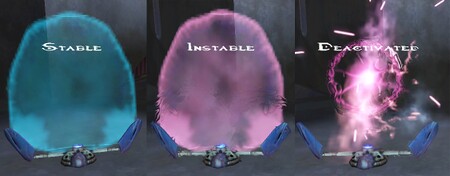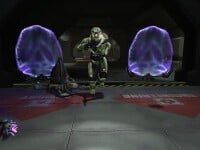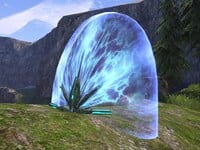Covenant portable shield: Difference between revisions
From Halopedia, the Halo wiki
mNo edit summary |
Halo Scout (talk | contribs) |
||
| Line 37: | Line 37: | ||
{{Main|Deployable Cover}} | {{Main|Deployable Cover}} | ||
[[File:Deployable Cover.jpg|thumb|A deployable cover.]] | [[File:Deployable Cover.jpg|thumb|A deployable cover.]] | ||
The deployable cover replaced the stationary shield generator in Halo 3. It is portable and curved rather than flat, and is | The deployable cover replaced the stationary shield generator in Halo 3. It is portable and curved rather than flat, and is destructable and much weaker from the other games. | ||
==Trivia== | ==Trivia== | ||
Revision as of 10:40, June 29, 2010
A Stationary Shield Generator is a device used by the Covenant during offensive ground operations. These shields are larger versions of the Point Defense Gauntlet used by Jackals, some Spartans, and some Elites. They are created by three small portable generators that are attached together and, when activated, provide extra protection for the Covenant troops. These are normally placed at strategic locations, like doors or building entrances, when the Covenant are guarding a small, temporary position. This information is derived from first-hand accounts, though it is unknown how the energy fields are generated. They can deflect all projectiles except rockets, explosions, or large amounts of plasma fire. In Halo: Combat Evolved if one of these shields is hit by a vehicle, it will be permanently disabled. In Halo 2, vehicles cannot collapse them on impact. In Halo 3 it reappears or was remade as a piece of Equipment, the Deployable Cover, where it can be deployed by troops.
Dimensions
Height: 2.49 meters (8.17 feet)
Locations

They can be found on the following levels:
- Halo: Combat Evolved/Halo PC
- Multiplayer
Deployable Cover
- Main article: Deployable Cover
The deployable cover replaced the stationary shield generator in Halo 3. It is portable and curved rather than flat, and is destructable and much weaker from the other games.
Trivia
- The AI won't see past shield generators since it acts as a solid, opaque object to the AI.
- If you fire at a shield with a human weapon, the shots may bounce back and do actual harm to you. This can be graphically demonstrated with a Sniper Rifle, and there have been instances of multiplayer suicides due to that particular scenario occurring.
- Only Plasma-based weapons are able to temporarily overload the shield's generator.
- If you have a Shotgun, or other long barreled weapon, and you walk right up against it, the barrel goes through and you can shoot through it at opposing enemies. Similarly, it is possible to snipe enemies while never having to expose yourself and take cover again. The length of the weapon which is exposed should be disregarded, since the shot from most weapons come from the camera.
- In Halo 2 on the level Delta Halo, shoot one of the stationary shield generators until it temporarily goes out. Get in a Ghost, and drive it onto the base of the generator. When it comes back up, it will flip the Ghost into the air, this will work on any vehicle, even a Scorpion Tank though often destroying whatever vehicle you use.
- In Halo 2, if you whack a Grunt body into a Stationary Shield Generator with the Sputnik Skull on, the Grunt's body will hit the Shield Generator hard enough to disable it.
- In Halo 2 if you stand on top of a deployed generator and shoot it with a plasma rifle the generator will overload and you will be floating on top of an invisible shield.

